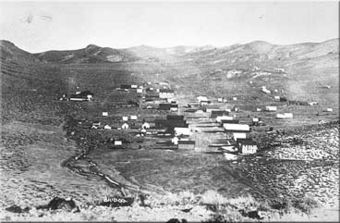Skidoo, California facts for kids
Quick facts for kids
Skidoo
|
|
|---|---|

Stamp batteries at Skidoo Mill
|
|
| Nickname(s):
23 Skidoo
|
|
| Country | United States |
| State | California |
| County | Inyo County |
| Elevation | 5,689 ft (1,734 m) |
|
Skidoo
|
|

Skidoo in 1906
|
|
| Lua error in Module:Location_map at line 420: attempt to index field 'wikibase' (a nil value). | |
| Location | Death Valley National Park, Wildrose District, California |
| Area | 4,160 acres (1,680 ha) |
| Built | 1906 |
| NRHP reference No. | 74000349 |
| Added to NRHP | April 16, 1974 |
Skidoo was once a small community in Inyo County, California. It was known as Hoveck for a short time. This old town site is located high up at 5,689 feet (1,734 meters) above sea level. Today, Skidoo is a ghost town found inside Death Valley National Park. It is also listed on the National Register of Historic Places, which means it's an important historical site.
Contents
What Was Skidoo?
Skidoo was a type of town called a "boom town." These towns grew very quickly when a valuable resource, like gold, was discovered nearby. Skidoo became active in the early 1900s because of the gold found at the Skidoo Mine.
How Did Skidoo Get Its Gold?
The main reason Skidoo existed was its gold mine. The Skidoo Mine operated from 1906 to 1917. During these years, the mine produced a lot of gold. About 75,000 ounces of gold were found, which was worth over $1.5 million at that time.
Special Mining Methods
Skidoo had some unique features for its time. It had the only gold processing plant in the desert that mostly used water power. This was very special because water is scarce in the desert.
Engineers also built an amazing water pipeline. This pipeline brought water all the way from near Telescope Peak to the mill. You can still see the path of this old pipeline today.
The mill itself was called a fifteen-stamp amalgamation and cyanide mill. It was built by the Skidoo Mines Company. This mill used a "gravity-feed system" to separate gold from its ore. This means materials moved through the mill using the force of gravity.
What Does "Skidoo" Mean?
The name Skidoo comes from a popular saying from that time: "23 skidoo." This was a slang phrase, and people have different ideas about where it came from.
The town's post office first opened in 1906 and was named Hoveck. This name honored Matt Hoveck, who was the manager of the Skidoo Mine. In 1907, the post office changed its name to Skidoo. It closed down in 1917, which was also when the mine stopped operating.
Images for kids



